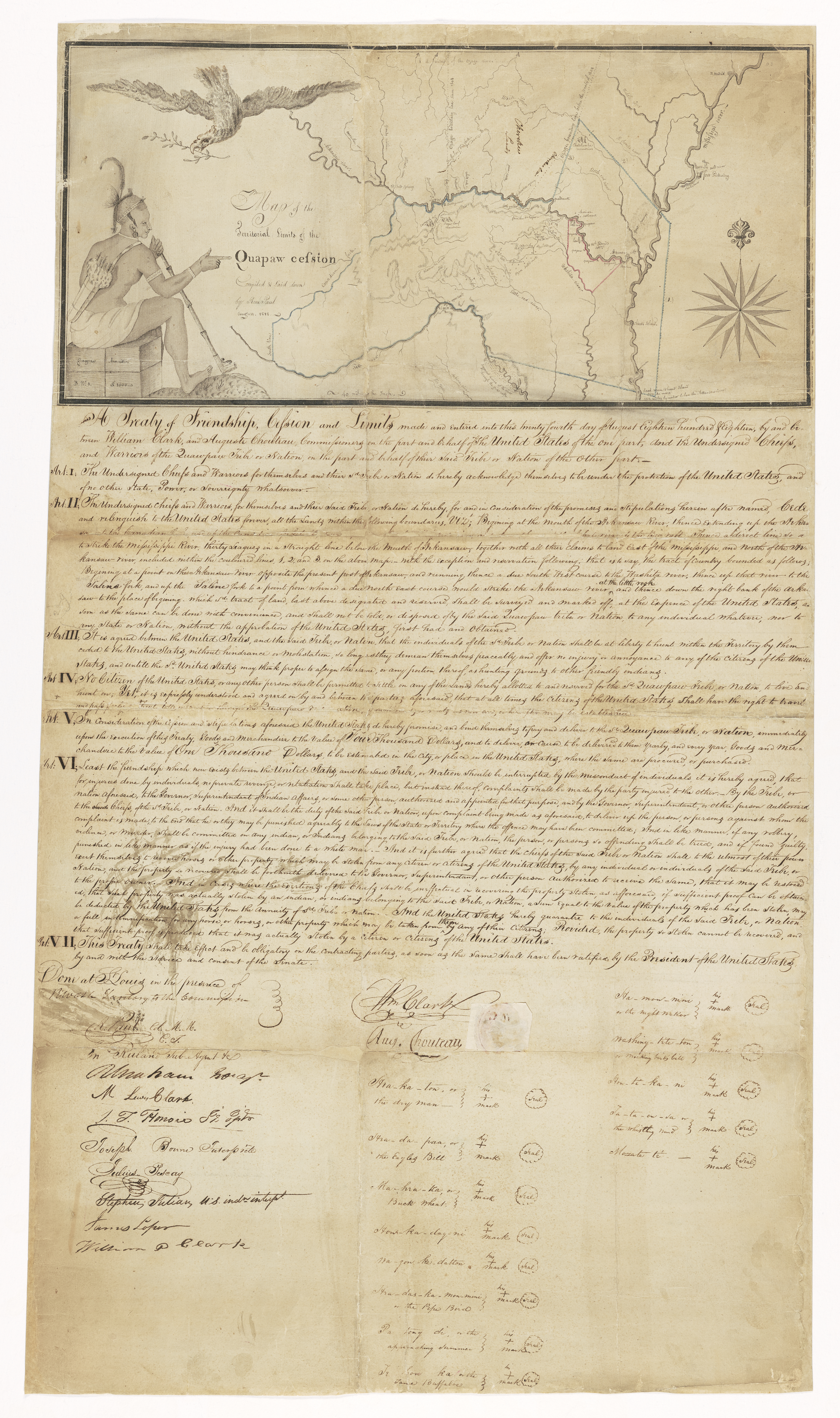Quapaw Treaty of 1818 To Go On View at the Smithsonian’s National Museum of the American Indian

National Archives, Washington, DC | Transcript: Originally published in Indian Affairs: Laws and Treaties, compiled and edited by Charles J. Kappler, 1904; digitized by Oklahoma State University.
The National Museum of the American Indian, in partnership with the National Archives and Records Administration, will display the Quapaw Treaty of 1818 in “Nation to Nation: Treaties Between the United States and American Indian Nations.” The treaty will be installed today, Wednesday, April 3, and will be on view until October 2024. To commemorate the event, a delegation from the Quapaw Nation, based in Oklahoma, will travel to Washington, D.C. Led by Chair Wena Supernaw, the delegation will join Cynthia Chavez Lamar (San Felipe Pueblo, Hopi, Tewa and Diné), director of the National Museum of the American Indian, and William (Jay) Bosanko, deputy archivist of the United States, for the unveiling.
When the U.S. negotiated the Treaty of 1818, the Quapaw lived in four towns along the lower Arkansas River, although their hunting territories extended broadly to the west. The U.S. wished to acquire rights to these territories, which they considered excess Quapaw land, with the idea that those lands might be used for the resettlement of eastern tribes dispossessed by removal. The U.S. offered a lump-sum payment, promises of more payments annually for perpetuity and a reservation composed of the territories occupied by the Quapaw towns. Just six years after the treaty was ratified, U.S. negotiators returned in 1824 at the behest of white settlers who desired the prime agricultural land of the lower Arkansas. The Quapaw were forced to abandon the 1818 reservation and move further west. Quapaw leader Heckaton, who felt compelled to agree to removal, said, “Since you have expressed a desire for us to remove, the tears have flowed copiously from my aged eyes.”
Displaying original treaties in “Nation to Nation” is made possible by the National Archives and Records Administration, an exhibition partner. Several of the treaties required extensive conservation treatment by the National Archives’ conservator prior to loan. Treaties can only be displayed for a short amount of time in order to conserve them for the future. There are a total of more than 370 ratified Indian treaties in the National Archives, and more information about these treaties is on its website. The current treaty on display at the National Museum of the American Indian is the 1867 Medicine Lodge Treaty.
The next treaty to go on display at the National Museum of the American Indian will be determined by curators at the museum in collaboration with conservators and staff at the National Archives.
Treaty Schedule
September 2014–February 2015 Treaty of Canandaigua, 1794
March 2015–August 2015 Muscogee Treaty, 1790
September 2015–February 2016 Horse Creek (Fort Laramie) Treaty, 1851
March 2016–August 2016 Treaty with the Potawatomi, 1836
September 2016–February 2017 Unratified California Treaty K, 1852
March 2017–August 2017 Medicine Creek Treaty, 1854
September 2017–January 2018 Treaty of Fort Wayne, 1809
February 2018–April 2018 Navajo Treaty, 1868
May 2018–October 2018 Treaty with the Delawares, 1778
November 2018–March 2019 Fort Laramie Treaty, 1868
April 2019–September 2019 Treaty of New Echota, 1835
October 2019–March 2020 Treaty of Fort Stanwix, 1784
October 2020–March 2021 Treaty of Fort Jackson, 1814
November 2021–May 2022 Treaty of Fort Harmar with the Six Nations, 1789
May 2022–November 2022 Treaty with the Nez Perce, 1868
November 2022–April 2023 Prairie du Chien Treaty, 1829
May 2023–October 2023 Treaty with Cheyenne and Arapaho, 1865
October 2023–April 2024 Medicine Lodge Creek Treaty, 1867
April 2024–October 2024 Treaty with the Quapaw, 1818
About the Museum
In partnership with Native peoples and their allies, the National Museum of the American Indian fosters a richer shared human experience through a more informed understanding of Native peoples. The museum in Washington, D.C., is located on the National Mall at Fourth Street and Independence Avenue S.W. For additional information, including hours and directions, visit AmericanIndian.si.edu. Follow the museum via social media on Facebook, X, Instagram, YouTube, Pinterest and LinkedIn.
About the National Archives
The National Archives ensures continuing access to the essential documentation of the rights of American citizens and the actions of their government. Its holdings include vast resources on Native Americans from as early as 1774 through the mid-1990s, including records from the Bureau of Indian Affairs in addition to the hundreds of original treaties between the U.S. and Native American tribal nations, now freely available online through the National Archives Catalog. Follow the National Archives on social media at Facebook, X, Instagram and LinkedIn.
# # #
SI-133-2024
